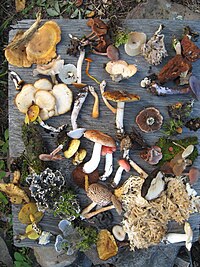
Photo from wikipedia
Modern agricultural practices have undeniably increased global food production. On the other hand, agricultural practices not only lead to a degradation of natural ecosystems but also affect the functioning of… Click to show full abstract
Modern agricultural practices have undeniably increased global food production. On the other hand, agricultural practices not only lead to a degradation of natural ecosystems but also affect the functioning of ecosystems and the related services they provide. Even though impacts of anthropogenic activities vary across ecosystems, freshwater ecosystems are among those affected to a higher degree. In comparison to surface water ecosystems, groundwater ecosystems are less affected by anthropogenic pollutants, as the overlaying soil retains organic and inorganic substances. However, it has become evident that the excessive use of fertilizers has led to the eutrophication of many aquifers. Bacterial communities, which significantly contribute to the cycling of matter due to their metabolic capacities, are prone to environmental perturbations, and structural variation of bacterial communities may consequently affect the functioning of groundwater ecosystems. Our present paper intends to evaluate the impact of anthropogenic activities on environmental conditions as well as on the structural properties of bacterial communities in groundwater. We repeatedly sampled emerging groundwater at five spring sites belonging to different catchments and determined the concentration of abiotic variables as well as the diversity and composition of bacterial communities on a local scale. We hypothesized that anthropogenic activities influence the concentration of abiotic variables, especially of nitrate, as well as the composition and diversity of bacterial communities in groundwater. Our results show that underground spring catchment areas only slightly differ regarding the concentration of abiotic variables as well as the structure of bacterial communities. Furthermore, abiotic variables, presumably influenced by anthropogenic activities, do not correlate with the diversity and composition of bacterial communities. Although supported only by circumstantial evidence, we suggest that upwelling groundwater from the deeper aquifer affects the diversity and composition of bacterial communities, and we argue that bacterial communities act as useful indicators for environmental changes.
Journal Title: MicrobiologyOpen
Year Published: 2019
Link to full text (if available)
Share on Social Media: Sign Up to like & get
recommendations!